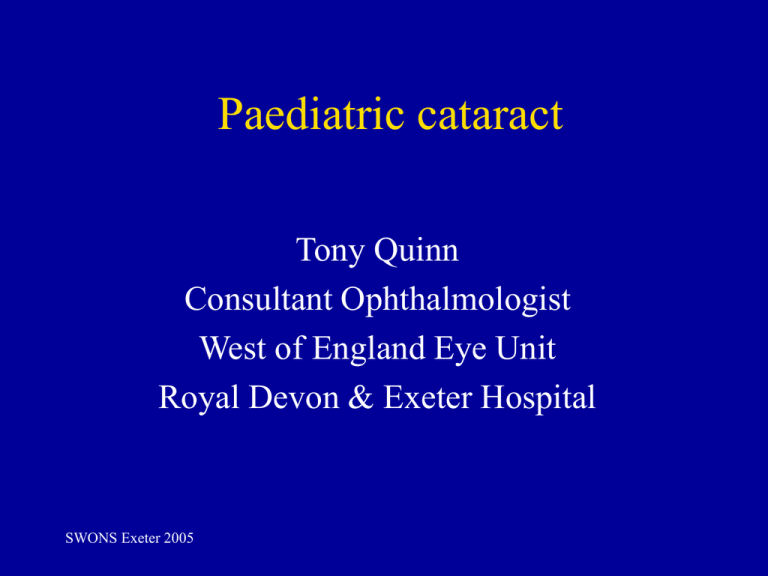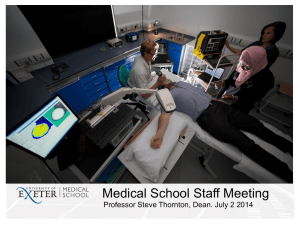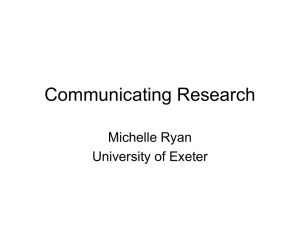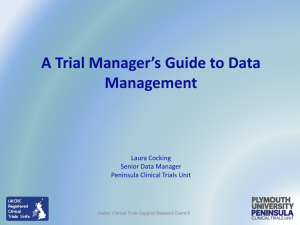Paediatric cataract
advertisement

Paediatric cataract Tony Quinn Consultant Ophthalmologist West of England Eye Unit Royal Devon & Exeter Hospital SWONS Exeter 2005 Outline • • • • • • • • • • What sort of cataract? Why do children get cataracts? What else could it be? What else occurs in association? Should we operate? What options are there? How soon should we treat? Complications? Controversies? IOL Implants? Outcomes? Our local results? SWONS Exeter 2005 What sort of cataract? Nuclear, lamellar, powdery, subcapsular, sutural, total • Can start off mild and become more dense • Obscures retinal image • May cause amblyopia SWONS Exeter 2005 Why do children get cataracts? • Gene mistake • Inherited • Associated with other genetic conditions (Paediatrician workup) • Trauma • Uveitis • Intrauterine infections SWONS Exeter 2005 What else could it be? • “white pupil” differential diagnosis • Retinoblastoma • Retinopathy of prematurity • Coat’s disease • Persistent fetal circulation SWONS Exeter 2005 What else occurs in association? • Main problem is amblyopia • Eye growth • Strabismus SWONS Exeter 2005 Should we operate? What options are there? • • • • • • Unilateral cataract: ? treatment Bilateral cataract: Treat if visually significant: Can you see in? Is opacity >=3mm? anterior or posterior ? Amblyopia, abnormal eye growth SWONS Exeter 2005 How soon should we treat? • <4 weeks may cause more glaucoma • More than 10 weeks may cause irreversible amblyopia, nystagmus • Unilateral about 6 weeks • Depends on how dense SWONS Exeter 2005 Surgery SWONS Exeter 2005 Complications? • Infection, bleeding, GA risk, loss of eye… • Big risks: Re-op • Glaucoma • Retinal detachment • Amblyopia • Strabismus • Glasses(bifocals) or Contact lens for sure SWONS Exeter 2005 What do we tell the parents? • Lifetime journey • Very hard work • Lots of drops early, then glasses and patching for years • May not work well (unilateral) • Long term risks • Risk to other eye (sympathetic) SWONS Exeter 2005 Controversies? IOL Implants? • • • • • • • IOL implants: when to use? Minimum age Minimum corneal diameter How long will they last? Rigid (?Heparin coated) or foldable? Where to place the lens? Dealing with posterior capsule SWONS Exeter 2005 Outcomes? • Excellent results possible • IOLs may be better overall than contact lenses. Not much in it • Refract, Refract, Refract!!! • May need EUA • Tonopen for awake IOP SWONS Exeter 2005 Our local results? Methods • • • • • Consecutive infant cataract surgery 00 - 03 9 infants, 15 eyes Mean age at surgery 21 weeks (4-42w) All posterior chamber, 13 in bag, 2 in sulcus 1 lost to follow up after 6 weeks SWONS Exeter 2005 Methods • primary pars plana Vx • IOL: Heparin PMMA in 5, Acrysof MA 60 BM in 10 (both 6 mm optic) • Healon 5 in 14, Healon GV in 1 • CCC in 14, MVR = 1 • 1 patient corneal diam 9.5 • 2 patients (4 eyes) nystagmus and strabismus pre-op SWONS Exeter 2005 Refractive target • +4 to +8D, (SRK-T) but max +30D IOL • Unilat Down +1.8D SWONS Exeter 2005 Refractive outcomes: mean followup 26.5 mo Infant Cataract Pseudophakic Refraction Changes Infant Cataract Pseudophakic Refractive Changes Average Sphere (Dioptres) 10 Average Sphere (Dioptres) 12 D Right A Right D Left A Left E Right B Right 10 E Left B Left 5 F Right C Right 8 F Left G Left H Right 6 H Left 0 4 2 -5 0 10 20 30 40 50 Time Post-Op (Months) SWONS Exeter 2005 0 10 20 30 Time Post-Op (Months) Vision outcomes mean 26.5 mo Comparison of Pre-op and 'Final' Visual Acuities 100 90 80 70 60 Percent of eyes (%) 50 PRE-OP FINAL 40 30 20 10 0 6/6-6-12 SWONS Exeter 2005 <6/12-6/60 <6/60-6/120 Range of Visual Acuity <6/120 Complications of surgery • • • • • Strabismus in 6 of 8 (1 lost to follow-up) Iris capture 1/14 Repeat posterior capsulectomy 6/14 Anterior capsule phimosis 1/14 Glaucoma nil mean 33 mo f/u. Mean IOP =14, range 1017mmHg • Retinal detachment nil • IOL decentred nil SWONS Exeter 2005 Conclusions • IOL implants in infants are possible with good visual and refractive outcomes • Myopic shift with time in most: ?emmetropisation • Mildly microphthalmic child showed almost no reduction in initial hypermetropia with time • High rate of strabismus • Nearly half re-op for “PCO” SWONS Exeter 2005






